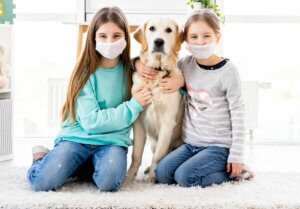Does the Use of Masks Confuse Dogs?

Society has accepted the use of masks as the new reality. Additional to social distancing, humans must use approved masks in order to prevent the spread of the new coronavirus. These masks cover a part of our face, and as a consequence, facial gestures lose expressiveness. Dogs are capable of reading and interpreting our gestures to a certain extent. But if they can only see a part of our face, there’s less information for them to rely on. Does this mean that masks confuse dogs? Find out in this article.
Dogs interpret our gestures
Your dog does understand when you talk to them. Even if it can’t understand everything you say, dogs can interpret our gestures, words, or emotions.
In fact, dogs have brain mechanisms very similar to ours. They process intonation with the right hemisphere and words with the left hemisphere. Thus, they not only know what we say, but also how we say it.
As if this wasn’t enough, they’re also able to identify the most recurrent words we use when communicating with them, and associate a meaning to them. Terms such as walk, food, and game are accompanied by a specific activity and the animal knows it.
Dogs don’t only pay attention to sounds, because nonverbal communication is equally or more important to them. Dogs distinguish a happy human face from an angry one, and understand what both expressions imply.

The faces experiment
There are many studies that tried to decipher how dogs interpret our expressions. Is what they learn from their owners transferable to strangers? Do they differentiate faces by certain facial features or as a whole?
Finnish researchers tried to answer these questions. They recorded the gaze of 31 dogs of 13 different breeds while carrying out a visualization exercise of photographs. These photographs show faces of humans and dogs with three basic emotional expressions: threatening, content and neutral.
By monitoring the dog’s gaze, the experts created maps on the photographs. They observed that dogs don’t base their perception of facial expressions on visualizing structures separately, but on the combination of the eyes, the center of the face, and the mouth.
Even if dogs watched their target’s eyes longer than the mouth, they made a sweep of the entire face. This means that they don’t rely on clues to interpret emotions —for example, the showing of teeth as an indication of happiness— but they evaluate our expression as a whole.
In addition to interpreting expressions, dogs reacted to them. By visualizing people’s angry faces, they would make calming signals and try to avoid them.
Do masks confuse dogs?
Masks cover the central part of the face, nose and mouth, and therefore, hide gestural information. However, the expressiveness of the eyes, the context, and verbal communication give them enough clues to understand the message.
In fact, dogs aren’t very visual animals. Even if a strange object on our face can cause some initial reaction, especially to reactive dogs, they are generally guided by their smell.
Masks may confuse dogs a little, but they use other visual, olfactory and sound clues to complete the information and understand the situation. For example, the tone of the voice is key for dogs. Thus, they can distinguish positive or negative messages only due to this aspect.
The use of masks isn’t a cause for concern in the daily life of dogs, especially when they live with us and are used to our way of acting, habits and schedule. Therefore, there’s no justification not to wear them in public places or to stop walking the pets.
Although some dogs may be surprised at first, the mask will stop being a big deal for them with time. If this isn’t the case and you think that it may generate behavioral problems for your pet, you can always consult a dog trainer.

Conclusions
The pandemic caused by the COVID-19 virus has no short-term solution. Therefore, we must all work together to prevent its spread. The dog, like any other animal exposed for a long time to the same stimulus, will get used to their owners using masks.
For all these reasons, we can summarize this entire debate with the following line. Don’t stop using your mask in public – protect yourself so that your dog will be able to see your complete face when you’re out and about one day very soon!
All cited sources were thoroughly reviewed by our team to ensure their quality, reliability, currency, and validity. The bibliography of this article was considered reliable and of academic or scientific accuracy.
- Dogs Evaluate Threatening Facial Expressions by Their Biological Validity – Evidence from Gazing Patterns. Somppi S, Törnqvist H, Kujala MV, Hänninen L, Krause CM, et al. (2016) Dogs Evaluate Threatening Facial Expressions by Their Biological Validity – Evidence from Gazing Patterns. PLOS ONE 11(1): e0143047.
- American Association for the Advancement of Science. (2016, August 29). Dogs understand both vocabulary and intonation of human speech. ScienceDaily.